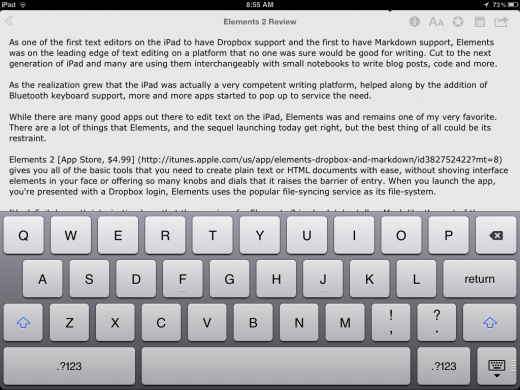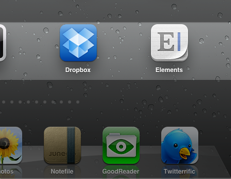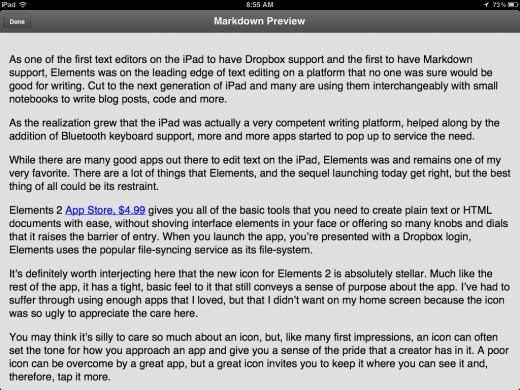
As one of the first text editors on the iPad to have Dropbox support and the first to have Markdown support, Elements was on the leading edge of text editing on a platform that no one was sure would be good for writing. Cut to the next generation of iPad and many are using them interchangeably with small notebooks to write blog posts, code and more.
As the realization grew that the iPad was actually a very competent writing platform, helped along by the addition of Bluetooth keyboard support, more and more apps started to pop up to service the need.
While there are many good apps out there to edit text on the iPad, Elements was and remains one of my very favorite. There are a lot of things that Elements, and the sequel launching today, get right, but the best thing of all could be its restraint.

Elements 2 [App Store, $4.99] gives you all of the basic tools that you need to create plain text or HTML documents with ease, without shoving interface elements in your face or offering so many knobs and dials that it raises the barrier of entry. When you launch the app, you’re presented with a Dropbox login, Elements uses the popular file-syncing service as its file-system.
It’s definitely worth interjecting here that the new icon for Elements 2 is absolutely stellar. Much like the rest of the app, it has a tight, basic feel to it that still conveys a sense of purpose about the app. I’ve had to suffer through using enough apps that I loved, but that I didn’t want on my home screen because the icon was so ugly to appreciate the care here.
You may think it’s silly to care so much about an icon, but, like many first impressions, an icon can often set the tone for how you approach an app and give you a sense of the pride that a creator has in it. A poor icon can be overcome by a great app, but a great icon invites you to keep it where you can see it and, therefore, tap it more.
Once you’ve logged in, you’re dropped right into the interface which, on the iPad, refreshingly eschews the standard ‘split-view’ iPad interface and instead presents you with a simple list of files that are stored in a, configurable, “Elements” folder in your Dropbox. On the iPhone you get a simple list view.
The text editing view is full-width and distraction free, with a nicely low-contrast set of tool icons in the upper right and punchy, high-contrast text. It amazes me how many text editors for iOS miss this mark and insist that you use a grey-on-grey scheme to edit text. The options across the top give you access to word and character counts, font size and color, a full Markdown preview, a small scratchpad for notes outside of your main document and a share button. The main settings menu allows you to change sorting and spelling options as well as toggle TextExpander support.

Markdown is a simple, plain language parser that allows you to write HTML text in regular english, without having to remember all of the exact markups for your formatting. Having it built in to Elements gives you the choice of editing plain text, writing pure HTML or using the simple syntax of Markdown to write quicker and more efficient marked up text. Markdown support is one of the crown jewels of Elements, but it’s better explained by its creator John Gruber here, so check that out if you’re interested.
I actually ‘learned’ to use Markdown while testing out Elements 2 for this review, and wrote portions of this text in it. It’s a very quick learn and if you write any sort of HTML text at all, it’s worth knowing as more editors are supporting it by the day. It also makes editing marked up text especially easy when you’re doing it directly on the iPad and iPhone’s screens as it doesn’t require as many switches of the keyboard back and forth from the special characters pane.

In addition to Dropbox support, Elements 2 also offers a significant upgrade to the variety of ways that you can push files out of it. You can email, print or export your files to HTML and PDF or into iTunes’ file system. But you can also now publish your documents to Evernote, Tumblr and Facebook, which adds a nice element of connectivity to the app. Justin Williams of Second Gear says that he is looking into adding more publishing services to Elements as well, but is waiting to see which platforms the users want the most before committing.
The market for text editors on the iPhone and iPad is ever-expanding, and many of the apps out there offer great features and an extensive array of options . Elements 2 takes a different tack. By exercising restraint in choice of features and a light hand with design, Second Gear has created a text editor that treats you like an adult. Freedom to just create content without a lot of editorial comments on how you should do it.
Elements 2 is available now on the App Store as a universal app for $4.99.
Get the TNW newsletter
Get the most important tech news in your inbox each week.





